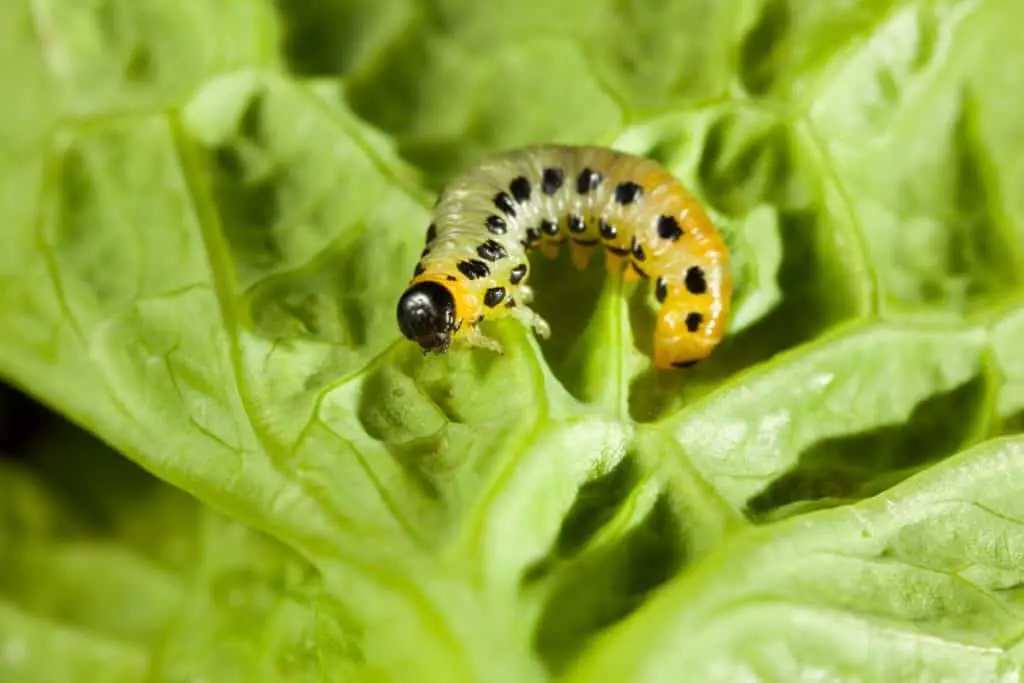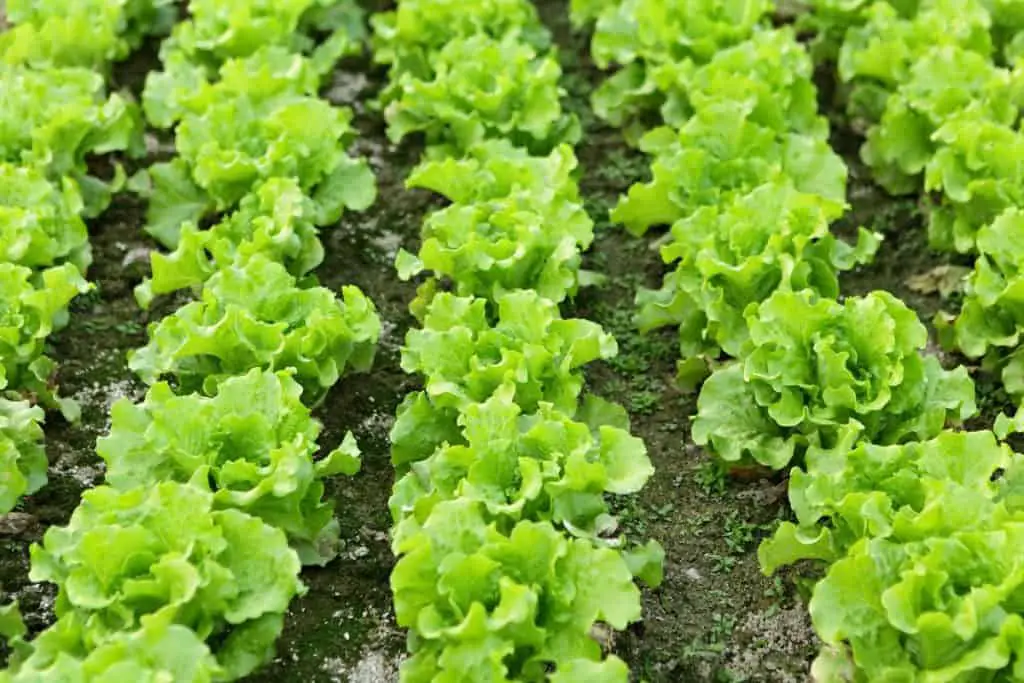Caterpillars are actually quite choosy eaters, and while they will munch on a wide variety of plants, some prefer to dine on those that are part of the mustard family.
This includes cabbage, broccoli, and yes, lettuce! In fact, it’s not uncommon for caterpillars to be found happily munching away on a head of lettuce leaves.
But, have you ever wondered why they choose to eat lettuce? After all, there are a wide variety of plants that caterpillars can eat, so what is it about lettuce that makes it such an appealing choice?
Why Do Caterpillars Eat Lettuce?
Caterpillars eat plants because they need to get nutrients in order to develop and grow and lettuce is an excellent source of these nutrients.
In fact, lettuce is one of their preferred foods since it’s high in protein, calcium, and other key nutrients.
Protein is essential for the growth and development of all animals and insects, including caterpillars. If they don’t get enough protein, they won’t be able to achieve the chrysalis stage.
Lettuce also contains other important nutrients like calcium, iron, magnesium, and Vitamins C, D, and B6. This provides the energy that they need to complete their metamorphosis.
| Amount Per Head Of Lettuce | (360)g |
|---|---|
| Calories | 53 |
| Protein | 4.9g |
| Total Fat | 0.5g |
| Carbohydrates | 10g |
| Cholesterol | 0 mg |
| Sodium | 100.8 mg |
| Potassium | 698.4 mg |
So as you can see, there are a number of reasons why caterpillars like to eat lettuce. First and foremost, it’s simply because it provides them with all the nutrients they need to survive!
What About Their Larvae?
Baby caterpillars generally eat the same things as full-grown caterpillars. This includes leaves, stems, and flowers from a wide variety of plants.
However, as before, this really depends on the type of species of caterpillar! Generally, both young and old caterpillars will typically feast on this leafy green vegetable.
In fact, lettuce is such a popular food source for many species of caterpillars that farmers often use net coverings to avoid their crops being eaten.
Related Article:

Types Of Caterpillars That Eat Lettuce
There are several different species of caterpillars that prefer to dine on lettuce. While each type is slightly different in size, color, and shape, they all share a similar preference for lettuce leaves.
Types Of Caterpillars That Eat Lettuce:
- The Cabbage Worm
- Cutworm Caterpillar
- Tobacco Hornworm
Cabbage Worms
Cabbage worms (Pieris rapae) are the offspring of white butterflies, and they’re experts at camouflage. They are green caterpillars that can easily blend in with the leaves, making them hard to spot.
They typically eat cabbage, however, they are also one of the most common caterpillars to eat lettuce. They can be very destructive, eating their way through an entire lettuce head in 48 hours.
Cutworm Caterpillar
Cutworms are small, thin caterpillars that chew through the stems of lettuce, causing them to wilt and die. They are most active at night and usually target younger plants, which makes them especially difficult to deal with.
In addition to lettuce, like the cabbage worm these caterpillars also like to munch on cabbage and other cruciferous vegetables.
Tobacco Hornworm
The tobacco hornworm (Manduca sexta) is another common species of caterpillar that loves to eat lettuce. They’re large and green, with distinctive straight white lines on its body with red horns at the tail end.
This caterpillar is also very similar and often confused with the tomato hornworm, but where tobacco hornworms have red horns, the tomato hornworms have dark blue or black horns.
How Much Lettuce Do Caterpillars Eat In One Day?
This really depends on the size of the caterpillar, as well as other factors such as temperature and humidity. However, some can eat an entire head of lettuce in just one day!
While not all species are this voracious, it’s common for caterpillars to consume a significant amount of plants on a daily basis.
This makes them a serious threat to commercial lettuce crops and can leave farmers struggling to protect their crops from these hungry pests.
This is where some farmers will use pesticides to help control the population of caterpillars eating their plants.
Related Article:

What About After They Turn Into A Butterfly?
No butterflies do not eat the lettuce only their larvae (caterpillars) Once they enter the Chrysalis Stages, caterpillars turn into butterflies and no longer have the same mouthparts.
Instead, butterflies have a straw-like mouth that is used to sip nectar and other sweet liquids and not chew as caterpillars do!
When you see butterflies flying above cabbage or lettuce it’s usually because they are looking for a safe place to lay their eggs and ensure the survival of their species.
How To Stop Caterpillars Eating Your Lettuce?
Although lettuce is good for caterpillars these insects can be a real pest to gardeners! They will often eat their way through an entire set of crops if given the chance.
If you have already noticed that the leaves of your lettuce have been completely stripped bare, or have holes in the leaves then it may be an indication that a caterpillar is close by.
The good news is that you can do a few things to prevent these critters from eating your precious lettuce plants.
Use Mess Or Row Covers
One of the best ways to stop caterpillars from eating your lettuce is to use row covers or a mesh cover. In fact, they are so effective farmers often use them to protect their crops from caterpillars and other insects.
These are usually made from lightweight fabric and help protect your plants from pests like caterpillars, as well as birds and other animals.
Use Pesticides Or Other Insecticides
If you find that you have a lot of caterpillars on your crops then another option would be to use pesticides! These chemicals are designed to kill insects like caterpillars, so they can be a very effective way of controlling these pests.
However, you should always be careful when using chemicals in your garden as they can have negative effects on other beneficial insects like bees and butterflies.
Conclusion
Overall, it’s important to be vigilant about monitoring your crops for signs of pests like caterpillars and taking action before they have a chance to cause any major damage.
The longer you leave it, the harder it can be to get rid of these insects and protect your plants.
Whether you’re using pesticides or covering your crops with a mesh material, there are plenty of options for keeping caterpillars away from your lettuce. So do whatever works best for you!
Related Article:
